Janie Geiser: Double Vision and The Fourth Watch
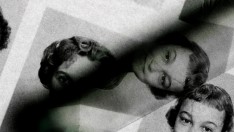
Double Vision
Sunday, October 8, 2023, 7:30 pm
At 2220 Arts + Archives, 2220 Beverly Blvd., Los Angeles CA 90057
In Person: Janie Geiser
First LA screening of her full Double Vision series!
LA premiere of newly restored print of The Fourth Watch
Dedicated to Bérénice Reynaud
Tickets: $15 general, $8 students/seniors, free for Filmforum members
At https://link.dice.fm/qeb4a86cd8b9
Masks are highly recommended at Filmforum shows - N95 or KN95.
Janie Geiser has crafted a cinematic universe that is both haunting and ethereal, inviting audiences to wander through the mossy labyrinthine corridors of memory, identity, and the enigmatic subconscious. Her films, characterized by their intricate set designs and innovative use of found objects, create a dreamscape that feels both familiar and surreal. Geiser's exploration of the mercurial nature of memory and time is masterful, often leaving viewers immersed in a delicate dance between the past and present.
Geiser's oeuvre is a mesmerizing testament to the power of film as art. Each frame in her films is a canvas, each figure a character, collectively painting an evocative portrait of the human psyche. As audiences journey through her landscapes, they find themselves enveloped in an experience beyond traditional cinema, embracing mystery and staying pensively lost in its fog. – Sam Gurry
Janie Geiser is a multidisciplinary artist whose practice includes cinema, performance, and installation. Geiser’s work is known for its recontextualization of abandoned images and objects, its embrace of artifice, and its investigation of memory, power and loss. Geiser’s films have been presented at the National Gallery of Art, MOMA, LACMA, Pacific Film Archive, Centre Pompidou, and at the NY Film Festival, SFIFF, TIFF, Viennale, and other venues. She is the recipient of a Guggenheim Fellowship, a Doris Duke Artist Award, and fellowships from Creative Capital and the Rockefeller Foundation, among others. Her film The Red Book was selected inclusion in the National Film Registry of the Library of Congress.
A pioneer of the renaissance of American avant-garde puppet performance, Geiser also creates innovative, hypnotic live performances that integrate performing objects and projection. She lives in Los Angeles, where she on the faculty of the School of Theater at CalArts, and co-directs Automata, an artist-run Los Angeles nonprofit dedicated to experimental performance and puppetry, experimental film, music, and installation. www.janiegeiser.com
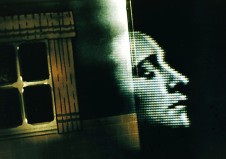
The Fourth Watch
The Fourth Watch
2000, 16mm, color, 10 min.
Music: Tom Recchion
Note: The Fourth Watch originally premiered in 2000 at the New York Film Festival’s Views from the Avant Garde. The film negative was lost when the lab it was at closed. The Fourth Watch was recently restored by Mark Toscano of the Academy Film Archives from an existing interpositive. This is the Los Angeles premiere of the newly restored print.
The Fourth Watch was selected as one of the top ten experimental films of the 2000’s by Film Comment.
The ancient Greeks divided the night into four sections; the last section before morning was called the fourth watch. In these hours before dawn, an endless succession of rooms is inhabited by silent film figures occupying flickering space in a midcentury house made of printed tin. Their presence is at once inevitable and uncanny. A boy turns his head in dread, a woman’s eyes look askance, a sleepwalker reaches into a cabinet that dissolves with her touch, and hands write letters behind disappearing windows. The rooms reveal themselves and fill with impossible, shadowed light. It is not clear who is watching and who is trespassing in this nocturnal drama of lost souls.
“A small masterpiece of the uncanny brought about through beautifully controlled use of superimposition and scale and a cross breeding of incompatible species of texture and
(cathode - solar) light. Glacial blue poltergeist -somnambulists, melodramatic stars and damaged
children from silent films - emerge at night into a tin dollhouse opening up invisible envelopes of space, comingling with hypnotic chiaroscura cast by trembling sunlight.”
---Mark McElhatten, program notes, New York Film Festival’s Views From the Avant-Garde
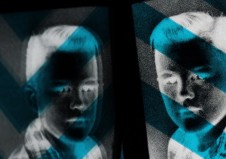
Double Vision
Double Vision (series, 2012-2018)
Double Vision is a series of 8 short films (2013-2018) that investigate the evocative instability and essentially fragmented nature of the photographic image. Abandoned and forgotten photographs and negatives, found thrift store images, lithograph book plates, and rediscovered family slides are forensically examined, reimagined, reframed, unmoored, and re-revealed in all their documentary truth and fiction.
"Geiser is a master of minimal means. In her series Double Vision, she recontextualizes outmoded images and photographs, arcane objects, and forgotten popular culture, releasing us into a sensual undercurrent of textures---the anteroom of suspended time."---Steve Anker, Film at REDCAT
“Geiser gives voice to the reaches of the unconscious, pointing to the abandoned splendor that exists prior to the rules of society and language.” - Holly Willis, RES
Including:
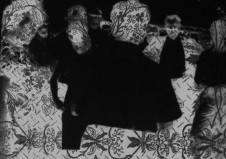
Arbor
Arbor
2012, Digital video, shot on 16mm, b&w, 8 min.
From a set of photographs found in a thrift store, Geiser creates a liminal space between representation and abstraction, figure and landscape, fiction and memory. Arbor suggests the fragility and ephemerality of memory and its artifacts through subtle manipulations of the photographs: reframings, layerings, inversions, and the introduction of dimensional elements, including flowers and leaves. The photographs’ subjects rarely engage the camera; they are glimpsed, rather than seen. They look elsewhere, and wait for something inevitable. Gathering on a hillside, lounging on the grass beyond now-lost trees, the inhabitants of Arbor cycle through their one elusive afternoon, gradually succumbing to time or dissolving into landscape, reserving for themselves what we can’t know---and becoming shadows in their own stories.
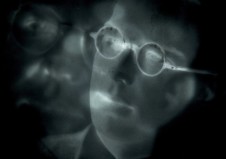
Cathode Garden
Cathode Garden
2015, Digital video, color, 8 min.
A young woman moves between light and dark, life and death; a latter day Persephone. The natural world responds accordingly. Neglected negatives, abandoned envelopes, botanical and anatomical illustrations, and found home-made recordings re-order themselves, collapsing and re-emerging in her liminal world.
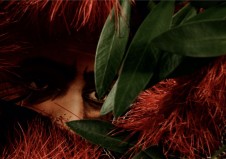
The Hummingbird Wars
The Hummingbird Wars
2014, Digital video, color, 11 min.
A theatrical fiction, collapsing time and place: turn-of-the-last-century performers apply stage makeup as if for war, to engage in battle for the soul of the world. The injuries are more emotional than physical, but cut deeply just the same. A visual/aural collage film, drawing on sources as seemingly disparate as Ibsen’s A Doll House, Japanese Gagaku music, makeup illustrations for 19th Century actors, the biography of a Shakespearean performer, blooming and decaying flowers, and a World War 1 First Aid Book, The Hummingbird Wars, suggests theater in a time of war, which is the theater of any time.
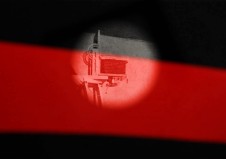
Kriminalistik
Kriminalistik
2013, Digital video, color, 5 min.
From the found book pages of an early twentieth century German book on forensics, Geiser uncovers hidden narratives. Evidence is scientifically arranged and catalogued, suggesting a corridor to memory. Elusive. Crimson.
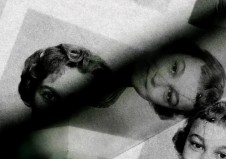
Look and Learn
Look and Learn
2017, Digital video, color, 11:15 min.
Look and Learn excavates the visual vocabulary we use to operate and construct the daily world. Look and Learn explores the juxtaposition of material image forms: visual instructions (assembly guides, photography manuals, maps, diagrams, elementary school workbooks) and photographs--- mainly a set of several 1950’s era elementary school group photographs. The visual instructions mimic maps in their hope of directing us to something, or somewhere, perhaps to a better understanding of our world and how things work.
These instructions fight for time with the school photos, which place groups of individual students into unforgiving grids. These photographs suggest a more orderly time when the instructions might actually be followed. The photos suggest another kind of diagram, forming barely glimpsed guides to the students’ future world. They look ahead to the 60’s and 70’s, when the imagined order of things will be exploded.
Look and Learn’s sound collage includes thrifted film soundtracks, as well as institutional alarms, contemporary field recordings, and short segments of speeches from the 1965 Berkeley Teach-In. The photographed students, born in the later 40’s and early 50’s, might have possibly found themselves caught up in the teach-ins, protests, and civil rights movements of the 60’s.
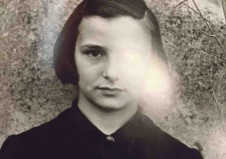
Fluorescent Girl
Fluorescent Girl
2018, Digital video, black and white / color , 1.5 min.
Fluorescent light reflects on a girl's image, found in a book of photographs in a bookstore. She merges with other images of shadow and light, highlighting her ephemerality and ours.
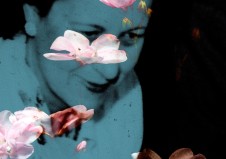
Flowers of the Sky
Flowers of the Sky
2016, Digital video, color, 9:12 minutes
Flowers of the Sky (a medieval term for comets) draws on two panoramic photographs, found in a Los Angeles thrift shop, that depict a gathering of members of the Eastern Star, a Masonic order. In the first photograph, taken at a banquet meal, the participants are seated at tables and facing the camera. In the second photograph, everyone is dressed in ritual robes, looking away from the camera and toward a stage. A single figure stands there, centered on this platform, and faces them. Everyone is suspended, expectant.
Through isolating parts of the photographs and highlighting the different groupings of the Eastern Star members, Flowers of the Sky reveals and obscures the original events. There is a sense, looking at the photographs, of watching and waiting for something to happen, something beyond the experience of daily life. And something does. Nature reasserts herself, the figures double, vibrate, and rise, trying to escape their emulsive lives, suggesting a rapture that extends beyond their printed world.
“In Flowers of the Sky, Janie Geiser elegantly submits two thrifted photographs to superimpositions and masking techniques in order to trouble and recast histories of the early 20th century.”----Andrea Picard, TIFF
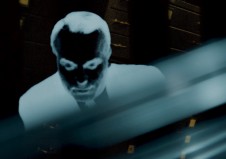
Valeria Street
Valeria Street
2018, Digital video, color, 11 min.
Music composed by Laura Steenburge
“The starting point for Valeria Street was a box of 7 slides that had fallen from a shelf in my studio. The slides depict a group of men, posed around a table, looking at a set of documents. They are in a generic office setting, with the blinds closed. Each slide is a different framing of the same event---clearly staged for the camera. In the center, seated, is one man. He holds a pen in his left hand. When I looked at the images, magnified through the camera lens, I saw that this was my father.
In recent films, I've been obsessed with unearthing possible and impossible narratives from photographs of strangers. Not knowing their histories, I’m able to imagine / construct new histories, while attempting to unearth something essential about these photographic documents. I was intrigued and somewhat frightened by the idea of working with these photographs of my father. The images suggest something about work and family, and about how much of a life is lived outside of each other's eyes.”----Janie Geiser
